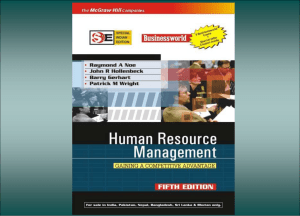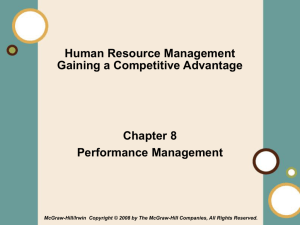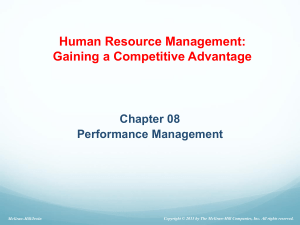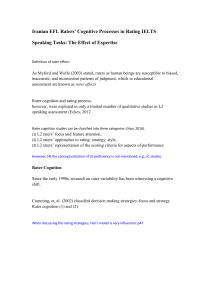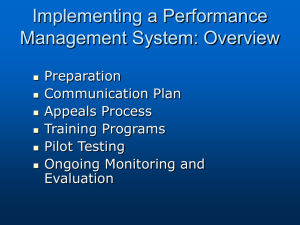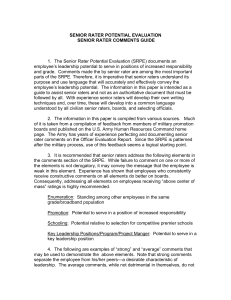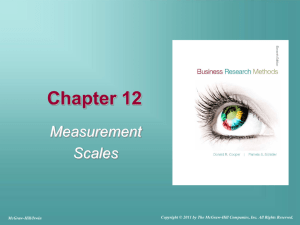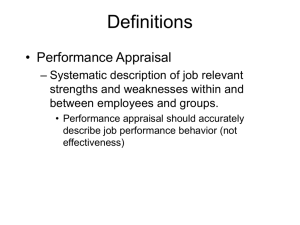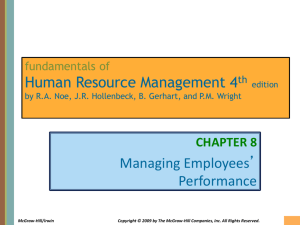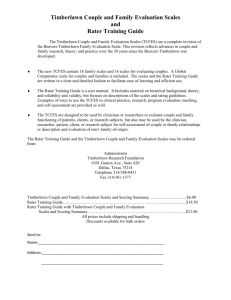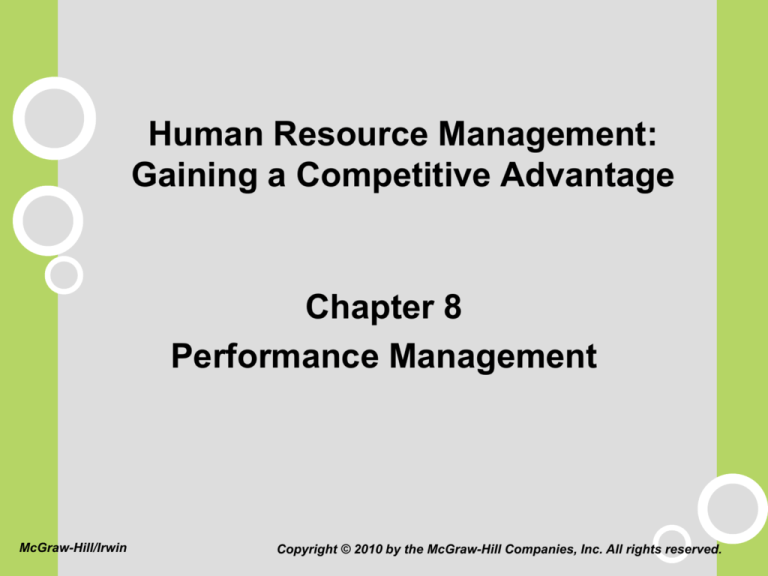
Human Resource Management:
Gaining a Competitive Advantage
Chapter 8
Performance Management
McGraw-Hill/Irwin
Copyright © 2010 by the McGraw-Hill Companies, Inc. All rights reserved.
Learning Objectives
Identify the major determinants of individual performance.
Discuss three purposes of performance management.
Identify five criteria for effective performance management
systems (pms) .
Discuss four approaches to performance management,
specific techniques used in each approach, and the way
these approaches compare with criteria for effective
performance management systems.
8-2
Learning Objectives
Choose the most effective approach to performance
measurement for a given situation.
Discuss advantages and disadvantages of different sources
of performance information.
Choose the most effective sources for performance
information.
Distinguish types of rating errors and explain how to
minimize each in a performance evaluation.
Conduct an effective performance feedback session.
Identify the cause of a performance problem.
8-3
Introduction
Performance management is the process through
which managers ensure that employees’ activities
and outputs are congruent with the organization's
goals.
Performance Appraisal is the process through
which an organization gets information on how well
an employee is doing his or her job.
Performance Feedback is the process of providing
employees information regarding their performance
effectiveness.
8-4
Performance Management Model
Organizational
Strategy
long & short
term goals&values
Individual
Attributes
Individual
Behaviors
(skills, abilities)
Objective
Results
Situational Constraints
culture & economic
conditions
8-5
3 Purposes of Performance Management
Strategic
Administrative
Developmental
8-6
Recommendations - Developing an Effective
Performance Management System
Mirror the corporate culture and values
Have visible CEO and senior management support.
Focus on the right company performance measures.
Link job descriptions to the performance management
system.
Differentiate performance fairly and effectively.
Train managers in performance management.
Communicate the total rewards system.
Require managers to search, offer and acquire regular
performance feedback.
Set clear expectations for employee development.
Track effectiveness of the performance management
system.
Adjust the system as required.
8-7
5 Performance Measures Criteria
Strategic Congruence
Specificity
Acceptability
Validity
Reliability
8-8
Comparative Approach
Ranking
– Simple ranking ranks employees from highest
to lowest performer.
– Alternation ranking - crossing off the best and
worst employees.
Forced distribution
– Employees are ranked in groups.
Paired comparison
– Managers compare every employee with every
other employee in the work group.
8-9
Attribute Approach
Graphic rating scales
– alist of traits is evaluated by a 5-point rating scale.
– legally questionable.
Mixed-standard scales
– define relevant performance dimensions
– develop statements representing good, average,
and poor performance along each dimension.
8-10
Behavioral Approach
Critical incidents approach - requires managers to keep
record of specific examples of effective and ineffective
performance.
Behaviorally anchored rating scales (BARS)
Behavioral observation scales (BOS)
Organizational behavior modification - a formal system of
behavioral feedback and reinforcement.
Assessment centers - multiple raters evaluate employees’
performance on a number of exercises.
8-11
Results Approach
Management by Objectives
– top management passes down
company’s strategic goals to managers
to define the goals.
Goals
Productivity Measurement and
Evaluation System (ProMES)
– goal is to motivate employees to
higher levels of productivity.
Hierarchy
8-12
Quality Approach
A performance management system designed
with a strong quality orientation can:
1. Assess both person and system factors in the
measurement system.
2. Emphasize managers and employees work together to
solve performance problems.
3. Involve both internal and external customers in setting
standards and measuring performance.
4. Use multiple sources to evaluate person and system
factors.
8-13
6 Statistical Process
Quality Control Techniques
1. Process-flow analysis
2. Cause-and-effect diagrams
3. Pareto chart
4. Control chart
5. Histogram
6. Scattergram
8-14
5 Performance Information Sources
Managers
Customers
Self
Peers
Subordinates
8-15
5 Performance Measurement Rater Errors
1. Similar to Me
2. Contrast
3. Distributional Errors
4. Halo and Horns
5. Appraisal Politics
8-16
Reducing Rater Errors and Politics
Approaches to Reducing Rater Error:
Rater error training
Rater accuracy training
Calibration Meetings- attended by
managers to discuss employee
performance ratings.
8-17
Improve Performance Feedback
1. Give feedback frequently, not once a year.
2. Create the right context for discussion.
3. Ask employees to rate performance before
thesession.
4. Encourage the employee to participate.
5. Recognize effective performance through praise.
6. Focus on solving problems.
7. Focus feedback on behavior or results, not on the
person.
8. Minimize criticism.
9. Agree to specific goals and set progress review date.
8-18
Input
Employee
Characteristics
5 Factors to
Consider
When Analyzing
Poor Performance
Feedback
Performance
Standards/
Goals
Consequences
8-19
Managing Performance of
Marginal Performers
Solid performers
High ability and motivation; provide development
Misdirected effort
Lack of ability but high motivation; focus on training
Underutilizers
High ability but lack motivation; focus on
interpersonal abilities
• Deadwood
Low ability and motivation; managerial action,
outplacement, demotion, firing.
8-20
Withstand Legal Scrutiny
1. Conduct a valid job analysis related to
performance.
2. Base system on specific behaviors or results.
3. Train raters to use system correctly.
4. Review performance ratings and allow for
employee appeal.
5. Provide guidance/support for poor
performers.
6. Use multiple raters.
8-21
Performance Management:
Electronic Monitoring
Electronic tracking systems include:
Hand and fingerprint recognition systems
Global positioning systems (GPS)
Systems thattrack employees using handheld
computers and cell phones
Potential increased efficiency and
productivity benefits
These systems present privacy concerns.
8-22
Summary
Measuring and managing performance are key to gaining
competitive edge.
Performance management systems (PMS) serve strategic,
administrative, and developmental purposes.
PMS should be evaluated against the criteria of strategic
congruence, validity, reliability, acceptability and specificity.
Effective managers need to
be aware of the issues involved in determining best methods.
feed performance information back to employees
take action based on causes for poor performance: ability,
motivation or both.
be sure that PMS can meet legal scrutiny
8-23

